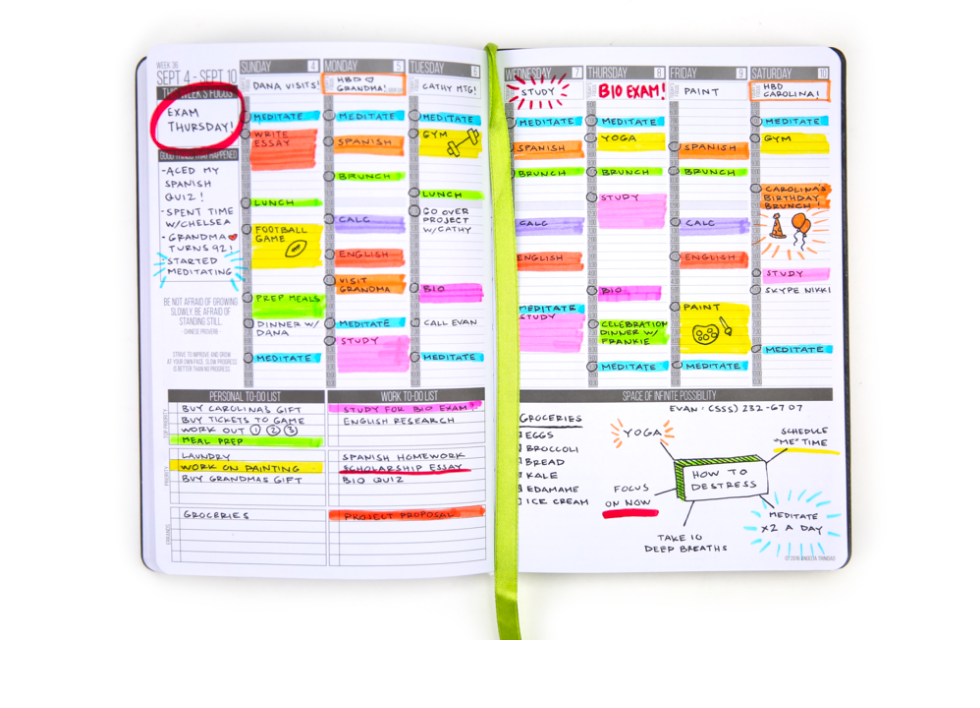“Whatever the mind can conceive and believe, it can achieve.” – Rhonda Byrnes
I know people are divided on The Secret, but don’t go! This post isn’t going to stroke the ego of The Secret; rather, it’s going to explore what makes things like visualization and vision boarding work — and how to find the benefits without sitting around wishing, hoping and praying.
Passive visualization can be one of the most frustrating things to introduce into your life. First, let’s take a step back into what visualization is.
Visualization has been explained by many over the years, and it’s something that we probably do (in a pretty undisciplined way) often. You probably heard about it from The Secret (is there anyone who hasn’t read the book or watched the movie?) or from Napoleon Hill’s “Think and Grow Rich.” It’s just as simple and as complex as it sounds. Visualize the life you want. Surround your senses with only things you want to achieve. Focus on those everyday.
Some greats in history have talked about the power of thought:
“Whether you think you can or think you can’t, either way you are right. (Henry Ford)
I truly believe that there’s great power in visualization for the sole reason that it forces you to assess every single thing you’re focusing on in your life, cut out the unneeded crap and drama, and stay hyper-focused on achieving your goals. It’s total sensory overload in a good way. It’s highly psychological. And I believe it works. Most people who choose to live a permissionless life believe that having control over their thoughts and mind will only further help them achieve success.
BUT.
Then passive visualization comes in.
Passive Visualization
The vision board has long been used as a way to visualize what you want out of life. I love the concept of it, and I think we do it whether we realize it or not. Hell, Pinterest allows us to visualize what we wish our lives were like every day. Except some of us will never reach baker status and make those awfully pretty holiday cookies (*cough* me).
When I see someone with a vision board and I ask them what they have planned to make those individual things happen and they say that if they put it out into the world, it’ll come to them… I want to shake them.
I suspect there’s two underlying reasons for this.
- If the Universe doesn’t deliver what they’re asking for, there must be a reason. Everything happens for a reason, right?
- It’s easy to put something out into the world and wish upon a star for it, and not have to deal with taking action and possibly failing (even though you can fail smartly).
Suddenly Rhonda Byrnes quote “Your thoughts become things” is used in the most literal sense of the sentence.
Thoughts → Things.
Active Visualization
Being active is key, and Thoughts DO become things, but much like success isn’t a straight line, neither is the path to achieving what you really want in life. You have to spin Thoughts Become Things on its head into something like the following,
Thoughts → Action → Action → BALLSY Action → Potential Failure → Action → MOAR THINGS.
Active visualization — something that helps you, me, athletes, (The book Mind Gym is a great example of how athletes visualize to perform at 110%) and everyone in between — is a bit different than the active visualization I’m referring to here; I’m referring to actually getting off your ass and doing something. I do provide a few active visualization resources at the bottom, which I’ll dive into at another time. 
“Make sure you visualize what you really want, not what someone else wants for you.” — Jerry Gillies
The secret to visualization is that it requires action. It’s grueling. It’s gritty. It’s not glamorous. But achieving success by identifying actions to get to your things is cool as cool could possibly be. If you’re thinking about visualization, don’t be passive. Be active. Here are some tips to get you started,
- Identify your Path: This is probably the toughest part when you’re looking to build towards a future full of passion, success and achievement. I highly suggest picking up Danielle Laporte’s Desire Map because it walks you through figuring out your passion and purpose with very specific steps and worksheets. Love x 10000.
- Choose your Mantra Words: Choose 3 mantra words that you’d like to continue to feel for the foreseable future. In the podcast, I have a tendency to ask guests which specific words that I list do they feel got them to where they were today, and which one would they like to improve upon or integrate into their life moving forward. I’d love for you to do the same exercise, however, encompass 3 words.
- Create Your Vision Board: Put those words on top of your vision board. Keep them in mind as you start cutting out magazine images and putting them on the board. Or, if you’re like me, taking the printed files from Office Max that came from a private Pinterest board because I have no idea what kinds of magazines even exist out there anymore. I won’t discuss the act of vision boarding in this post, because there are lots of excellent resources (listed at the bottom of this post.)
- Get a Planning Tool: Pick up a planner (I’m obsessed. There are so many planners out there) and start actually piecing out your goals. As I mentioned in the Pivotal Points vs. Goals post, try to plan milestones and pivotal points rather than very specific goals that hinge on the success of the other. Or, trade the word “milestones” for goals, but continue to move towards your pivotal points. Whatever works best for you.
Here are some planning examples,
Passion Planner

Best Self

Ink & Volt (Formerly Spark Notebook)

Desire Map Planner
 Some people prefer planning online. If that’s your cup of tea (it’s mine, sometimes) then go for it!
Some people prefer planning online. If that’s your cup of tea (it’s mine, sometimes) then go for it!
I’d love to hear what you’re visualization, how your vision boarding is going, and how you feel in general about the process. It’s not for everyone – I fought it for a very long time – but it definitely helps get your head in the game.
Active Visualization Resources
“When I’m preparing for a swim, I imagine absolutely everything about it: the color of the water, how cold it is, the taste of salt in my mouth. I visualize each and every stroke.” — Lewis Gordon Pugh
- An Easy Visualization Technique – http://www.gaia.com/article/easy-visualization-technique
- Does Visualization Really Work? Here’s Evidence That It Does – http://expertenough.com/1898/visualization-works
Creating a Vision Board
“Visualize this thing that you want, see it, feel it, believe in it. Make your mental blueprint, and begin to build.” — Robert Collier
Here’s a few quick resources if you’d like to read more.
- How to Make A Vision Board that Works – http://artfulparent.com/2014/12/make-vision-board-works-10-steps.html
- The Reasons Vision Boards Work and How to Make One – http://www.huffingtonpost.com/elizabeth-rider/the-scientific-reason-why_b_6392274.html
- Virtual Dreamboard – https://dreamitalive.com/
Leave a Reply